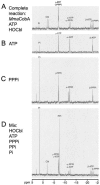Studies of the CobA-type ATP:Co(I)rrinoid adenosyltransferase enzyme of Methanosarcina mazei strain Go1
- PMID: 16672609
- PMCID: PMC1482872
- DOI: 10.1128/JB.188.10.3543-3550.2006
Studies of the CobA-type ATP:Co(I)rrinoid adenosyltransferase enzyme of Methanosarcina mazei strain Go1
Abstract
Although methanogenic archaea use B(12) extensively as a methyl carrier for methanogenesis, little is known about B(12) metabolism in these prokaryotes or any other archaea. To improve our understanding of how B(12) metabolism differs between bacteria and archaea, the gene encoding the ATP:co(I)rrinoid adenosyltransferase in Methanosarcina mazei strain Gö1 (open reading frame MM3138, referred to as cobA(Mm) here) was cloned and used to restore coenzyme B(12) synthesis in a Salmonella enterica strain lacking the housekeeping CobA enzyme. cobA(Mm) protein was purified and its initial biochemical analysis performed. In vitro, the activity is enhanced 2.5-fold by the addition of Ca(2+) ions, but the activity was not enhanced by Mg(2+) and, unlike the S. enterica CobA enzyme, it was >50% inhibited by Mn(2+). The CobA(Mm) enzyme had a K(m)(ATP) of 3 microM and a K(m)(HOCbl) of 1 microM. Unlike the S. enterica enzyme, CobA(Mm) used cobalamin (Cbl) as a substrate better than cobinamide (Cbi; a Cbl precursor); the beta phosphate of ATP was required for binding to the enzyme. A striking difference between CobA(Se) and CobA(Mm) was the use of ADP as a substrate by CobA(Mm), suggesting an important role for the gamma phosphate of ATP in binding. The results from (31)P-nuclear magnetic resonance spectroscopy experiments showed that triphosphate (PPP(i)) is the reaction by-product; no cleavage of PPP(i) was observed, and the enzyme was only slightly inhibited by pyrophosphate (PP(i)). The data suggested substantial variations in ATP binding and probably corrinoid binding between CobA(Se) and CobA(Mm) enzymes.
Figures







References
-
- Bauer, C. B., M. V. Fonseca, H. M. Holden, J. B. Thoden, T. B. Thompson, J. C. Escalante-Semerena, and I. Rayment. 2001. Three-dimensional structure of ATP:corrinoid adenosyltransferase from Salmonella typhimurium in its free state, complexed with MgATP, or complexed with hydroxycobalamin and MgATP. Biochemistry 40:361-374. - PubMed
-
- Brautigam, C. A., Y. Chelliah, and J. Deisenhofer. 2004. Tetramerization and ATP binding by a protein comprising the A, B, and C domains of rat synapsin I. J. Biol. Chem. 279:11948-11956. - PubMed
Publication types
MeSH terms
Substances
Grants and funding
LinkOut - more resources
Full Text Sources
Molecular Biology Databases
Miscellaneous

